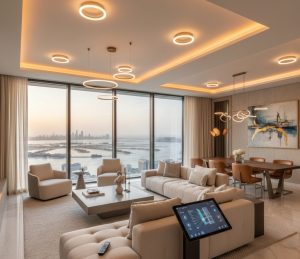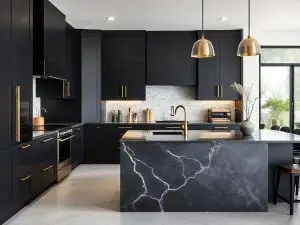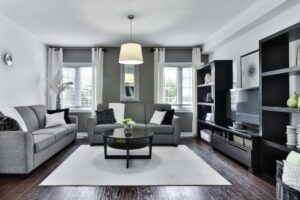Sustainable Luxury Interiors for Dubai Villas: Where Opulence Meets Environmental Responsibility
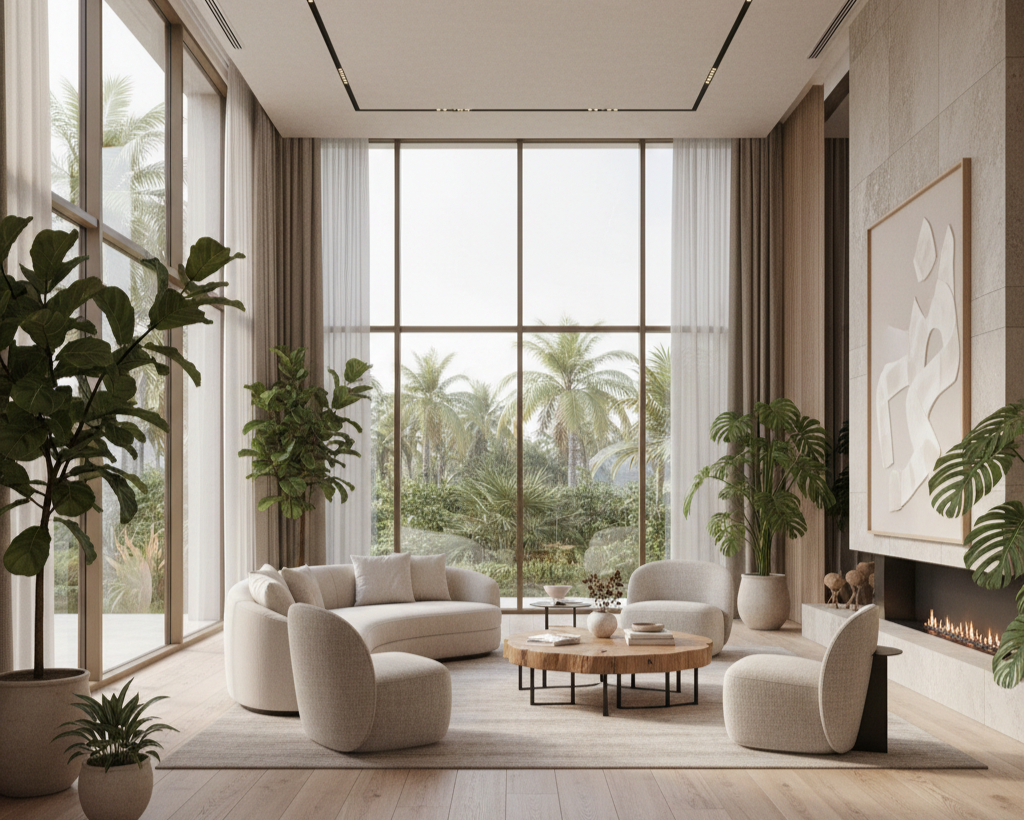
As someone who’s witnessed the transformation of Dubai’s interior design landscape, I can tell you that sustainable luxury interiors Dubai are no longer a contradictory term. It’s the future. And frankly, it’s about time.
The shift towards eco-friendly villa design Dubai represents more than just a trend—it’s a fundamental reimagining of what luxury means in the 21st century. With Dubai’s ambitious 2040 Urban Master Plan targeting significant carbon reduction and the allocation of 60% of the emirate’s total area for nature reserves and rural development, villa owners are increasingly aligning their interior choices with broader environmental goals.
Why Sustainable Interior Design Matters in Dubai’s Unique Context
Let’s address the elephant in the room—or rather, the 50°C heat outside the room. Dubai’s extreme climate and rapid urbanisation present unique sustainability challenges that make eco-conscious design not just admirable, but essential.
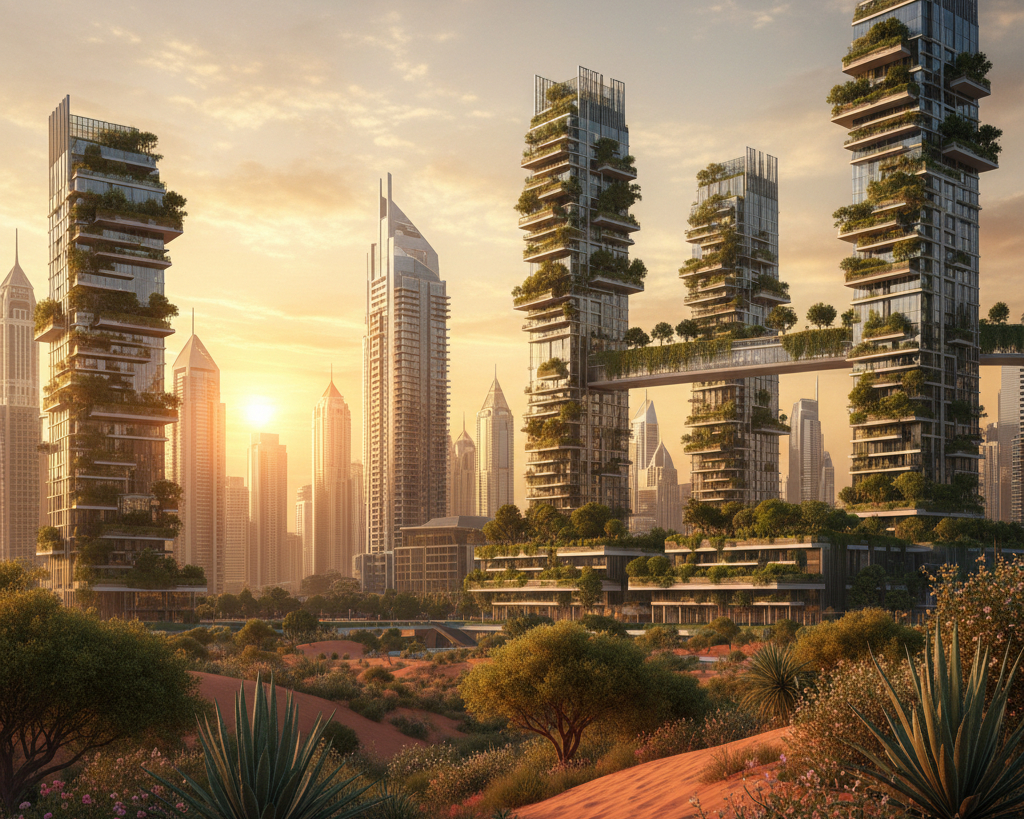
The Environmental Imperative
Dubai’s 2040 Urban Master Plan isn’t just bureaucratic paperwork—it’s a comprehensive roadmap targeting a 30% reduction in carbon footprint by 2030 and aiming for the lowest carbon footprint of any major city by 2040. For villa owners, this translates into both opportunity and incentive to embrace sustainable design principles.
The Tangible Benefits for Villa Owners
- Dramatic Energy Savings: Sustainable villas in Dubai report energy consumption reductions of 40-45% through LED conversion, smart HVAC controls, and improved insulation. One recent Dubai Marina penthouse transformation saved AED 12,000 annually whilst reducing energy use by 45%.
- Enhanced Property Value: Properties with sustainable features are commanding premium prices. That same Dubai Marina project increased in value by AED 250,000 following its eco-friendly renovation—a substantial return on an AED 180,000 investment.
- Superior Indoor Air Quality: In a city where dust storms are routine and buildings are hermetically sealed, sustainable materials and air purification systems create noticeably healthier living environments. This is particularly crucial for families with children or pets.
- Long-term Durability: Quality sustainable materials chosen for Dubai’s harsh climate—sealed natural stone, UV-resistant fabrics, and moisture-resistant bamboo—outlast their conventional counterparts, reducing replacement costs.
- Alignment with Global Standards: LEED certification and adherence to Dubai Green Building Regulations not only add prestige but also position properties favourably in an increasingly eco-conscious luxury market.
Core Elements of Sustainable Luxury Villa Design
1. Eco-Friendly Materials That Don’t Compromise on Elegance
Here’s where sustainable design gets exciting. The materials available today offer character and sophistication that mass-produced alternatives simply cannot match.
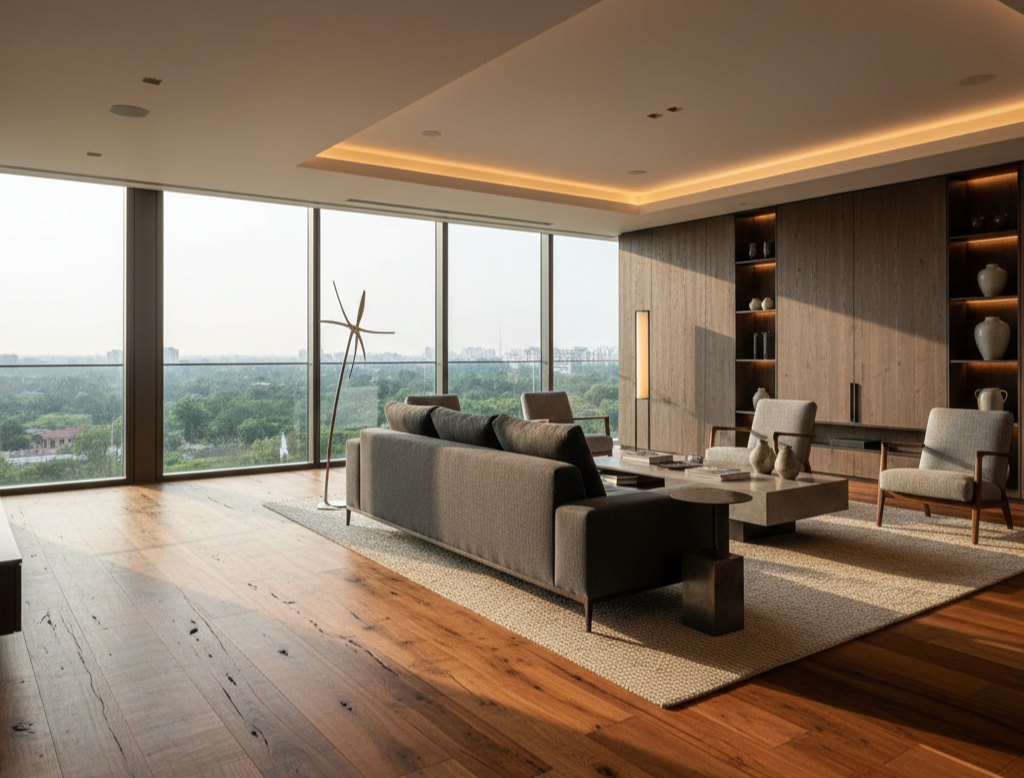
Reclaimed Wood: History Meets Modernity
Each piece of reclaimed wood tells a story through unique grain patterns impossible to replicate in new timber. Whether sourced from old dhows, historic buildings, or responsibly reclaimed forests, this material adds warmth and authenticity whilst significantly reducing deforestation. It’s particularly effective for statement flooring, ceiling features, and bespoke furniture pieces.
Bamboo: The Unsung Hero
Don’t let bamboo’s humble reputation fool you. This fast-growing marvel (some species grow up to 91cm in 24 hours!) offers exceptional moisture resistance—invaluable in Dubai’s climate-controlled environments. Modern bamboo flooring rivals hardwood in durability and aesthetics, whilst bamboo cabinetry provides a contemporary edge.
Natural Stone with Purpose
Whilst Dubai has always embraced stone, sustainable sourcing makes the difference. Locally quarried stone reduces carbon footprint from transportation, whilst its thermal mass helps moderate indoor temperatures. For 2025, dramatic stones like Panda White, Calacatta Viola, and Nero Marquina are trending—oversized slabs with high-contrast veining that become visual centrepieces.
Recycled Metals and Glass
Recycled metals offer unique finishes unavailable in new materials—think patinated copper fixtures or brushed recycled aluminium accents. They’re ideal for lighting fixtures, bathroom fittings, and architectural details. Recycled glass, meanwhile, can be transformed into stunning light fixtures or decorative elements.
Low-VOC and Natural Paints
Volatile Organic Compounds (VOCs) in traditional paints release harmful chemicals for years after application. Low-VOC alternatives, natural clay plasters, lime-based finishes, and even milk paint ensure better air quality without compromising on colour richness or durability. In Dubai’s sealed environments, this choice significantly impacts indoor air quality.
Pro Tip: When selecting materials for Dubai’s climate, prioritise those tested for heat resistance, UV stability, and moisture performance. Ceramic tiles that resist heat expansion, sealed natural stone, and UV-resistant fabrics ensure your sustainable choices remain beautiful for decades.
2. Energy-Efficient Solutions That Actually Work in Desert Heat
Dubai’s climate isn’t just hot—it’s relentlessly, energy-consumingly hot. But that same abundant sunshine that challenges our cooling systems also presents our greatest renewable energy opportunity.
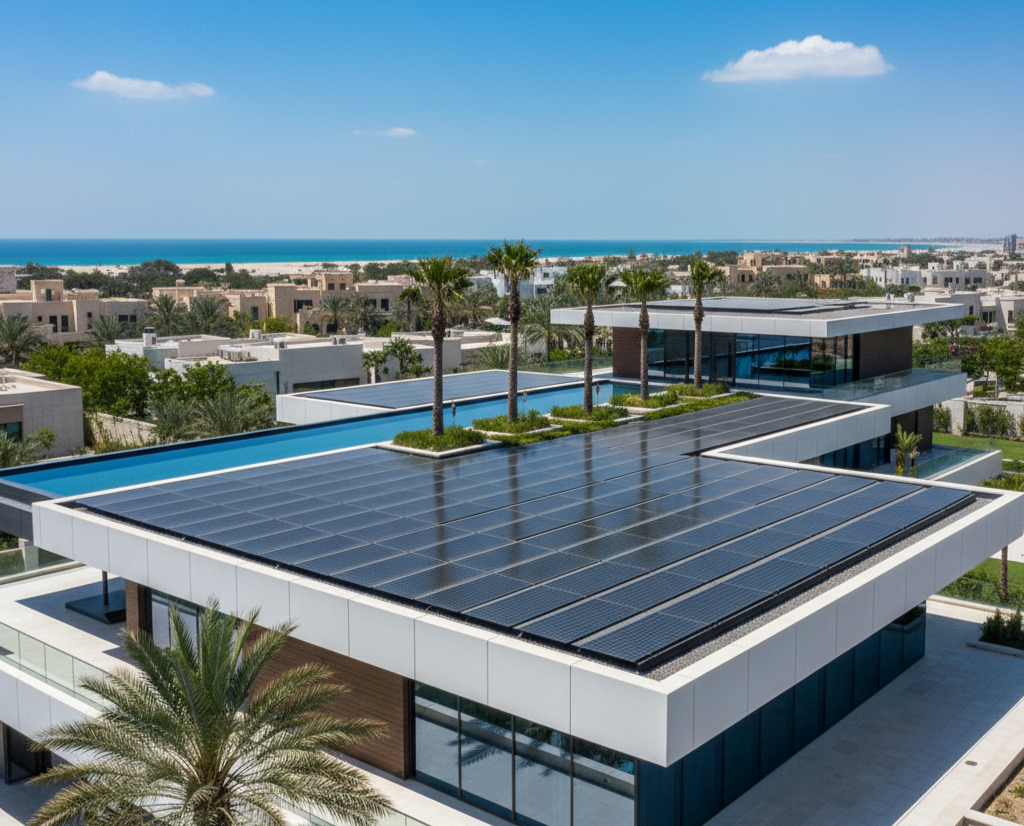
Solar Integration Done Right
Modern solar solutions have evolved far beyond the clunky panels of yesterday. Today’s systems can be architecturally integrated, powering everything from primary electrical needs to pool heating and outdoor lighting. Given Dubai’s 300+ days of sunshine annually, solar investment pays dividends.
LED Lighting: The Low-Hanging Fruit
Switching to LED bulbs uses up to 75% less energy than traditional incandescent bulbs and produces significantly less heat—crucial in a climate where traditional bulbs actually increase air conditioning demands. Smart lighting systems connected to HVAC adjust brightness and colour temperature based on natural light and occupancy, further enhancing savings.
Smart Home Systems: Elegance Meets Efficiency
Today’s smart home technology isn’t just about convenience (though voice-activated blinds are rather nice). Properly configured systems optimise energy use by:
- Learning occupancy patterns and adjusting climate control accordingly
- Managing lighting zones to ensure lights are only on where needed
- Providing detailed consumption analytics to identify savings opportunities
- Integrating with renewable energy systems for optimal efficiency
- Detecting leaks and system inefficiencies before they become costly problems
Energy-Efficient HVAC: The Make-or-Break Investment
In Dubai, HVAC accounts for up to 70% of residential energy consumption. Modern energy-efficient systems designed specifically for Dubai’s climate, combined with improved insulation (green roofs, vertical gardens), can slash cooling costs whilst maintaining perfect comfort. The investment pays for itself surprisingly quickly.
3. Water Conservation: Luxury Without Waste
Water scarcity is Dubai’s Achilles heel, making conservation not just responsible but critical. The good news? Modern water-saving solutions deliver spa-like experiences whilst using significantly less water.
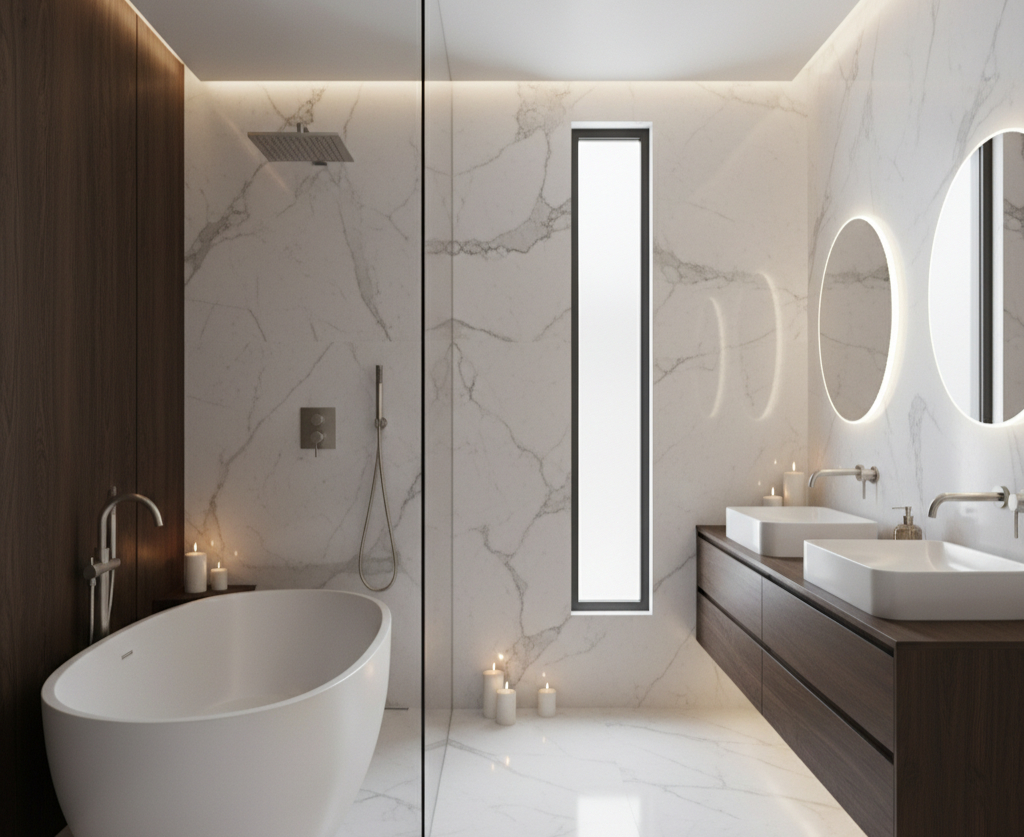
Smart Fixtures That Feel Luxurious
- Rainfall Showerheads with Flow Restrictors: Provide that abundant water sensation whilst conserving resources
- Dual-Flush Toilets: Offer options for different waste types, optimising water use
- Pull-Out Kitchen Sprayers: Deliver targeted water exactly where needed
- Low-Flow Taps: Maintain excellent pressure whilst reducing consumption by up to 60%
Greywater Systems: Close the Loop
Greywater systems recycle water from sinks, showers, and washing machines for garden irrigation and landscaping. In Dubai’s arid environment, this can reduce outdoor water consumption by up to 70%. That Palm Jumeirah villa garden? It can thrive on recycled water.
Drought-Tolerant Landscaping
Creating lush outdoor spaces doesn’t require water-guzzling lawns. Native and adapted species—succulents, desert roses, bougainvillaea—create stunning, low-maintenance gardens that respect Dubai’s natural environment.
4. Indoor Air Quality: Breathing Luxury
When you live in sealed, air-conditioned environments, indoor air quality becomes paramount. This is where sustainable design directly impacts daily well-being.
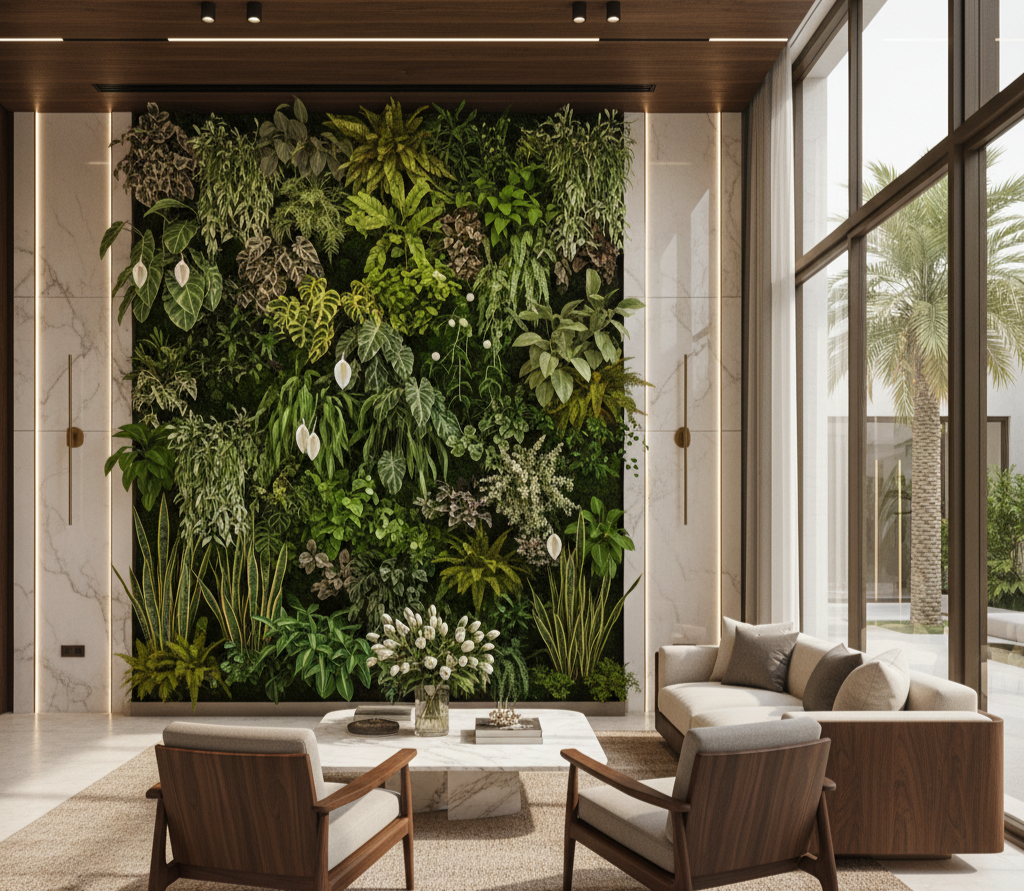
The Power of Plants
Air-purifying plants aren’t just decorative—they’re functional. Snake plants, peace lilies, spider plants, and pothos actively filter toxins whilst adding natural beauty. Living walls and vertical gardens have become particularly popular in Dubai villas, creating stunning focal points whilst improving air quality.
Natural Ventilation Strategies
Whilst full natural ventilation isn’t practical year-round in Dubai, strategic window placement, mashrabiya screens, and covered terraces can facilitate airflow during cooler months, reducing HVAC dependence and connecting interiors with the outdoors.
Advanced Air Purification
High-quality air purification systems with HEPA filters remove dust, allergens, and pollutants—essential in a city prone to dust storms. When combined with low-VOC materials and regular ventilation, the result is noticeably cleaner, healthier air.
The Dubai 2040 Connection: Your Villa as Part of a Larger Vision
The Dubai 2040 Urban Master Plan represents one of the most ambitious urban transformation initiatives globally. Understanding it helps contextualise why sustainable villa design isn’t just good practice—it’s aligning with the emirate’s future.
Key Sustainability Targets
- Allocating 60% of Dubai’s total area for nature reserves and rural development
- Reducing carbon footprint by 30% by 2030
- Achieving the lowest carbon footprint of any major city by 2040
- Doubling green and leisure spaces
- Increasing public beach length by 400%
- Producing 75% of energy from clean sources by 2050
- Creating the “20-minute city” where residents can access 80% of their daily needs within a 20-minute walk or cycle
For villa owners, this means properties incorporating sustainable features will increasingly align with regulatory expectations, market demands, and community standards. Early adopters aren’t just being environmentally responsible—they’re future-proofing their investments.
Real-World Transformation: A Palm Jumeirah Success Story
The Challenge
A five-bedroom villa in Palm Jumeirah needed a complete renovation. The clients wanted luxury and sophistication but were adamant about environmental responsibility. They had two teenagers, making healthy indoor air quality a priority.
The Solution
- Materials: Reclaimed teak flooring throughout, bamboo cabinetry in kitchen and bathrooms, recycled copper lighting fixtures, low-VOC paints in warm earth tones
- Energy Systems: Solar panels integrated into roof design, LED lighting throughout with smart home control, energy-efficient HVAC with zone controls
- Water Conservation: Low-flow fixtures in all bathrooms, dual-flush toilets, greywater system for garden irrigation, drought-tolerant landscaping featuring native species
- Air Quality: Living wall in main reception, air-purifying plants throughout, advanced HEPA filtration system, natural ventilation in transitional spaces
The Results
- Energy consumption reduced by 42%
- Water usage decreased by 38%
- Annual utility savings: AED 14,500
- Property value increased by an estimated AED 280,000
- Family reported significantly improved indoor air quality and reduced allergies
- Total investment: AED 195,000
- Payback period: approximately 13 years (not including property value increase)
Your Roadmap to Sustainable Luxury: Practical Steps
Start Small, Think Big
You don’t need a complete renovation to embrace sustainable design. Begin with high-impact, low-cost changes:
- Replace all bulbs with LEDs (immediate 75% lighting energy reduction)
- Install a smart thermostat (typically pays for itself within a year)
- Add air-purifying plants to every room
- Switch to low-VOC cleaning products
- Replace bathroom fixtures with low-flow alternatives
Work with Experts Who Understand Both Luxury and Sustainability
The intersection of high-end aesthetics and environmental responsibility requires specific expertise. Look for designers who:
- Have demonstrable experience with sustainable luxury projects
- Understand Dubai’s climate-specific challenges and solutions
- Can source quality sustainable materials suitable for local conditions
- Hold or work towards LEED accreditation or similar certifications
- Prioritise lifecycle analysis, not just upfront costs
Invest in Quality, Not Quantity
Sustainable luxury is about curation, not accumulation. One exceptional piece of furniture crafted from responsibly sourced materials and built to last decades holds more value—both aesthetic and environmental—than multiple disposable alternatives. This approach also aligns beautifully with the 2025 trend towards bespoke, artisanal pieces over mass-produced furnishings.
Embrace Local Sourcing
Dubai and the broader UAE have growing communities of artisans and suppliers working with sustainable materials. Local sourcing reduces carbon footprint from transportation whilst supporting regional craftsmanship. Plus, locally sourced stone and materials are already proven to withstand local climate conditions.
Consider Lifecycle, Not Just Aesthetics
True sustainable design considers the entire lifecycle:
- Sourcing: How and where were materials obtained?
- Manufacturing: What was the environmental impact of production?
- Durability: Will this material withstand Dubai’s climate for decades?
- Maintenance: Does it require toxic cleaning products or excessive upkeep?
- End of Life: Can it be recycled, repurposed, or will it end up in a landfill?
2025 Trends: Where Sustainable Luxury Is Heading
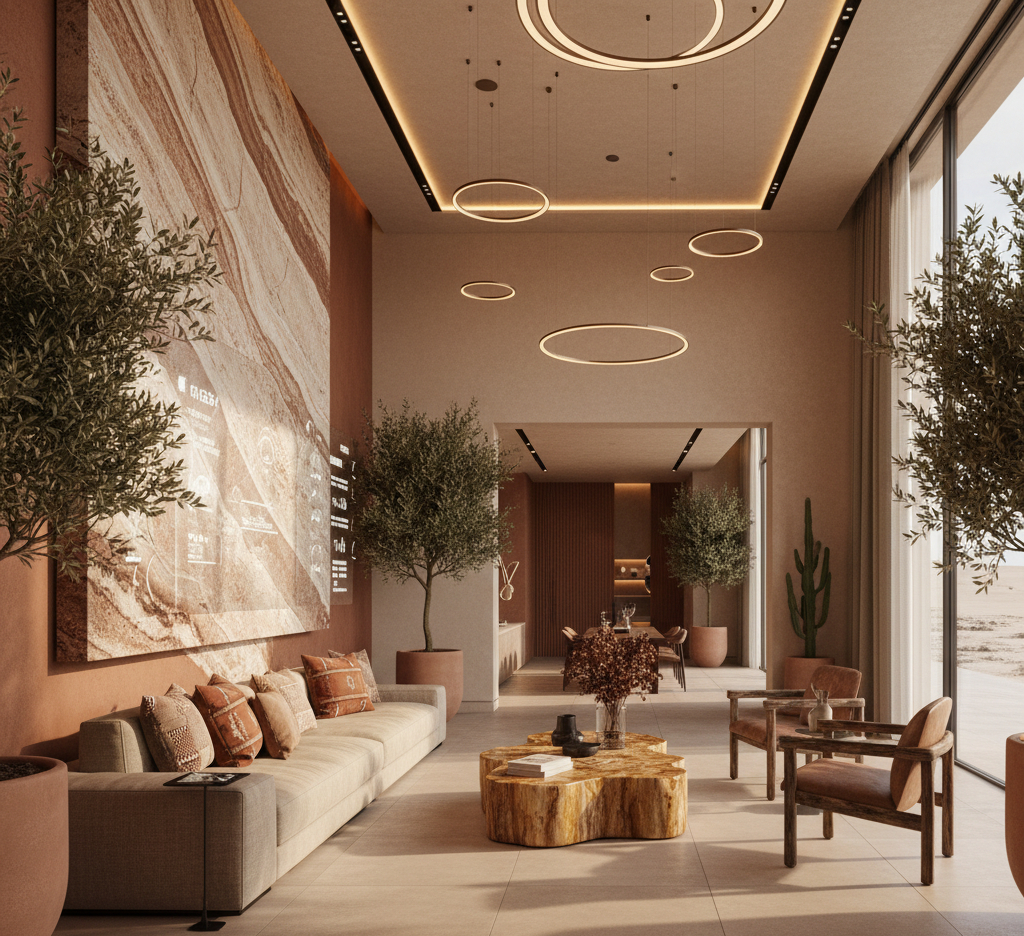
Desert-Inspired Colour Palettes
Earthy, neutral palettes inspired by Dubai’s natural landscape—sandy beige, terracotta, warm taupe, sun-faded rose, clay—are dominating 2025 interiors. These tones create warmth and timeless elegance whilst connecting homes to their environment. Bold jewel tones like emerald and sapphire provide dramatic accents.
Bespoke Over Mass-Produced
The era of mass-produced luxury is ending. Villa owners increasingly commission custom furniture tailored to their space, lifestyle, and values. This approach reduces waste from ill-fitting pieces whilst creating truly unique interiors. Artisanal craftsmanship is particularly valued, with handmade pieces commanding a premium status.
Biophilic Design Goes Mainstream
Integrating nature into interiors, aka. Biophilic Design isn’t just trendy—it’s become essential. Living walls, indoor water features, maximised natural light, organic shapes, and abundant greenery create wellness-focused environments. In Dubai’s urban context, this connection to nature provides crucial psychological benefits.
Dramatic Sustainable Stones
High-drama natural stones with bold veining are replacing subtle finishes. These stones—sustainably sourced—often extend beyond traditional applications into furniture design. Think dining tables carved from single marble slabs or console tables featuring dramatic stone inlays.
Smart Sustainability
AI-powered home systems are optimising not just comfort but sustainability. These systems learn patterns, predict needs, and adjust energy use for maximum efficiency. Integration is key—lighting, HVAC, water systems, and security all working together intelligently.
Cultural Fusion
Contemporary sustainable design in Dubai increasingly celebrates Emirati heritage alongside global influences. Arabic calligraphy etched into sustainably sourced marble, mashrabiya screens reimagined in recycled materials, traditional textiles reinterpreted with organic fabrics—this fusion creates spaces that are both modern and rooted.
Busting Common Myths About Sustainable Luxury
Myth 1: “Sustainable Means Sacrificing Style”
Reality: Modern sustainable materials often offer superior aesthetics. Reclaimed wood has a character impossible to replicate. Natural stone provides unmatched depth. Artisanal pieces create uniqueness. If anything, sustainable choices elevate style by prioritising quality and authenticity over mass production.
Myth 2: “It’s Too Expensive”
Reality: Whilst some sustainable materials have higher upfront costs, lifecycle analysis tells a different story. Durable materials last longer, energy-efficient systems save thousands annually, water conservation reduces bills, and property values increase. That Dubai Marina penthouse saw a 139% return on its sustainable renovation investment—not including ongoing savings.
Myth 3: “Sustainable Design Doesn’t Work in Dubai’s Climate”
Reality: Quite the opposite. Materials chosen for Dubai’s climate—sealed stone, UV-resistant fabrics, moisture-resistant bamboo—actually perform better than conventional alternatives. Solar energy is more effective here than almost anywhere else. Sustainable design principles like thermal mass and strategic ventilation are particularly effective in desert climates.
Myth 4: “It’s Too Complicated”
Reality: Starting with simple changes—LED bulbs, low-flow fixtures, indoor plants—requires no expertise. For comprehensive renovations, experienced designers handle complexity. The process needn’t be more complicated than conventional design; it’s just more thoughtful.
Myth 5: “Sustainable Options Are Limited”
Reality: Dubai’s sustainable design market has exploded. Local suppliers stock everything from reclaimed wood to recycled glass tiles. International sustainable luxury brands actively target the Dubai market. If anything, the challenge is choosing from abundant options, not finding them.
The Future Is Sustainable (Whether We Like It or Not)
Here’s the thing about sustainable luxury in Dubai—it’s not really optional anymore. Between government initiatives, market demands, and the practical realities of climate change, sustainable design is becoming simply “design.” The villas being built and renovated today either embrace this reality or risk obsolescence.
But here’s the more exciting reality: sustainable luxury actually delivers better living spaces. Healthier air. More comfortable temperatures. Lower operating costs. Unique aesthetics. Connection to nature. Homes that tell stories rather than simply displaying wealth.
Dubai has always been about pushing boundaries and setting global standards. Sustainable luxury interiors Dubai represent the next frontier—proving that environmental responsibility and opulent living aren’t opposing forces but complementary partners in creating the future of luxury living.
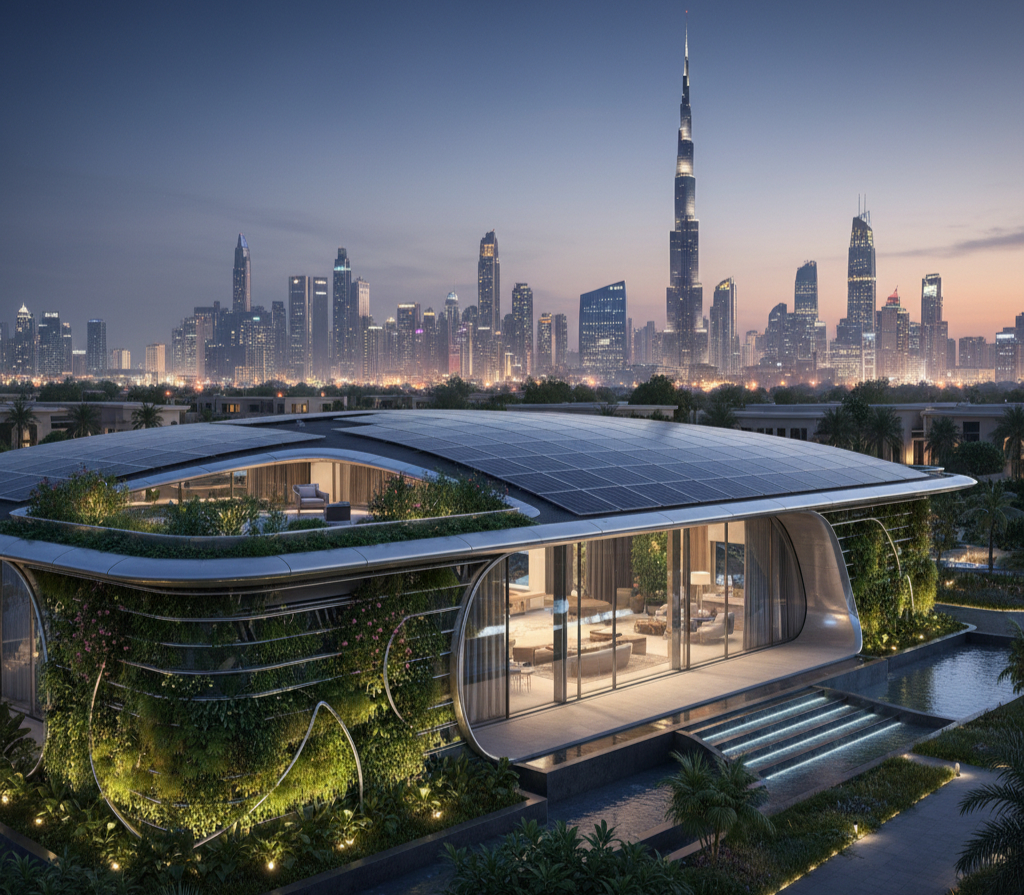
Ready to Transform Your Villa?
Creating a sustainable luxury villa in Dubai isn’t just a trend—it’s a commitment to a better future for your family and your investment. Whether you’re planning a complete renovation or considering strategic upgrades, the journey begins with education and the right partners.
Your Next Steps:
- Audit Your Current Space: Identify areas where sustainable upgrades would have the most impact—typically HVAC, lighting, and water systems.
- Define Your Priorities: What matters most? Energy savings? Air quality? Water conservation? Aesthetic authenticity? This guides material and system choices.
- Research Designers: Look for firms with demonstrated sustainable luxury experience in Dubai’s climate.
- Start Small or Go Big: Either approach works. Small changes create momentum; comprehensive renovations maximise impact.
- Think Long-term: Sustainable design is an investment. Consider 10-20 year horizons, not just immediate costs.
Your villa can be a testament to sophisticated living that treads lightly on the planet. It can be healthier, more beautiful, more valuable, and more uniquely yours than anything mass-produced or conventional could achieve.
The future of luxury is sustainable. The question is: will your villa lead the way or follow behind?
Frequently Asked Questions
What exactly is sustainable interior design?
Sustainable interior design creates spaces that minimise environmental impact whilst maximising health, efficiency, and longevity. It involves using eco-friendly materials (reclaimed wood, bamboo, recycled metals), implementing energy-efficient systems (LED lighting, smart HVAC, solar power), conserving water, improving air quality, and considering the entire lifecycle of materials and products. In luxury contexts, it means achieving all this whilst maintaining or elevating aesthetic sophistication.
Why is sustainable design particularly important in Dubai?
Dubai faces unique environmental challenges: extreme heat driving massive energy consumption, water scarcity in a desert climate, rapid urbanisation, and air quality issues from dust and sealed buildings. Additionally, Dubai’s 2040 Urban Master Plan commits to significant sustainability targets, including 30% carbon reduction by 2030. Sustainable design addresses these practical challenges whilst aligning properties with regulatory trends and market expectations.
Does sustainable design really save money, or is that just marketing?
The savings are very real and documentable. LED lighting reduces electricity consumption by up to 75%. Smart HVAC systems can cut cooling costs by 40-45%. Low-flow fixtures reduce water bills by 30-60%. Solar systems eventually pay for themselves through eliminated or reduced electricity costs. One documented Dubai Marina project saved AED 12,000 annually. Over a property’s lifetime, these savings far exceed the modest premium on initial sustainable investments.
Will sustainable materials hold up in Dubai’s harsh climate?
When properly selected, sustainable materials often outperform conventional alternatives in Dubai’s climate. Bamboo offers superior moisture resistance. Sealed natural stone provides thermal mass that moderates temperature. UV-resistant organic fabrics maintain colour and integrity. Ceramic tiles resist heat expansion. The key is working with designers who understand which sustainable materials are proven for local conditions and specifying appropriate treatments and finishes.
How much does a sustainable villa renovation cost compared to a conventional renovation?
Initial costs for sustainable materials and systems can be 10-20% higher than conventional alternatives, though this gap is narrowing rapidly. However, lifecycle costs are typically lower due to durability, reduced maintenance, and ongoing utility savings. Additionally, sustainable renovations often increase property values significantly—one documented case showed a 139% return on investment when including the property value increase, not even accounting for ongoing savings.
Can I incorporate sustainable design if I’m not doing a complete renovation?
Absolutely. Start with high-impact changes: switch to LED bulbs, install a smart thermostat, add air-purifying plants, replace bathroom fixtures with low-flow alternatives, switch to low-VOC cleaning products, and add solar-powered outdoor lighting. These changes require minimal investment but create measurable impact. You can also adopt a phased approach, updating rooms or systems progressively as budgets allow.
How do I find sustainable materials and suppliers in Dubai?
Dubai’s sustainable design market has grown significantly. Look for suppliers certified by organisations like the Forest Stewardship Council (FSC) for wood products. Many established interior suppliers now stock sustainable lines. Working with an experienced sustainable design firm provides access to their supplier networks. Local artisans increasingly work with reclaimed and sustainable materials. Online platforms also connect buyers with verified sustainable product sources.
Does sustainable design work with different interior styles, or just modern/minimalist?
Sustainable design principles work beautifully across all aesthetic styles. Contemporary minimalism, classic elegance, Arabic fusion, Mediterranean, and industrial—all can incorporate sustainable materials and systems. Reclaimed wood suits both rustic and contemporary spaces. Natural stone works in traditional and modern contexts. Bamboo can be sleek or organic. The key is material selection and application, not stylistic restriction. Sustainability is about process and impact, not aesthetic limitation.
What about maintenance? Are sustainable materials more difficult to care for?
Generally, no, often quite the opposite. Quality sustainable materials like sealed bamboo, properly finished reclaimed wood, and natural stone typically require less maintenance than synthetic alternatives because they’re chosen for durability. Low-VOC paints clean easily. Natural fabrics often resist staining better when properly treated. Plants require regular care, but offset this with air purification benefits. Smart systems often include maintenance alerts and diagnostics, preventing problems before they become costly.
Will installing solar panels affect my villa’s aesthetics?
Modern solar integration has evolved dramatically. Today’s systems can be architecturally incorporated into roof design, making them virtually invisible from ground level. Solar tiles that mimic traditional roofing materials are increasingly available. Panels can be positioned on flat roof sections not visible from main viewing angles. Pergolas and shaded areas can incorporate solar whilst serving additional functions. Work with designers who understand both solar efficiency and aesthetic integration.
How long does it typically take to recoup the investment in sustainable features?
Payback periods vary by feature. LED lighting pays for itself within months. Smart thermostats typically recoup costs within 1-2 years. Solar systems may take 8-12 years but last 25+ years. Water-saving fixtures pay back within 3-5 years. Comprehensive sustainable renovations, when considering utility savings alone, typically show 10-15 year payback periods. However, when factoring in property value increases (often substantial), effective payback can be immediate. Plus, improved quality of life and environmental impact have value beyond pure financial calculations.
Final Thoughts: Luxury Redefined
The conversation about luxury is changing. For decades, luxury meant abundance without consideration—the bigger chandelier, the rarer marble, the most exotic wood, regardless of origin or impact. But today’s truly sophisticated homeowners understand that real luxury means thoughtfulness, quality, longevity, and positive impact.
Sustainable luxury interiors Dubai isn’t about sacrifice or compromise. It’s about evolution—creating homes that are healthier, more beautiful, more valuable, and more aligned with the future we’re building together. It’s about spaces that feel good, not just aesthetically, but ethically. Homes that tell stories of craftsmanship, responsibility, and vision rather than just displaying wealth.
Your villa is more than a property—it’s your daily environment, your family’s health, your contribution to Dubai’s future, and your legacy. Making it sustainable isn’t just responsible; it’s the smartest, most sophisticated choice you can make.
The future of luxury is already here. It’s sustainable, it’s beautiful, and it’s waiting for you to embrace it.
Ready to Begin Your Sustainable Luxury Journey?
Transform your Dubai villa into a masterpiece of sustainable sophistication.
Contact us today to discuss how we can bring your vision to life whilst honouring both luxury and environmental responsibility.
Udostępnij:
- Kliknij, aby udostępnić na Facebooku (Otwiera się w nowym oknie) Facebook
- Kliknij, aby udostępnić na Pinterest (Otwiera się w nowym oknie) Pinterest
- Kliknij, aby udostępnić na X (Otwiera się w nowym oknie) X
- Kliknij, aby udostępnić na LinkedIn (Otwiera się w nowym oknie) LinkedIn
- Kliknij aby podzielić się na Reddit (Otwiera się w nowym oknie) Reddit
- Kliknij, aby wysłać odnośnik e-mailem do znajomego (Otwiera się w nowym oknie) E-mail
- Kliknij by wydrukować (Otwiera się w nowym oknie) Drukuj

